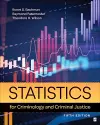
Statistics for Criminology and Criminal Justice
3 authors - Paperback
£158.00
Ronet D. Bachman, PhD, worked as a statistician at the Bureau of Justice Statistics, U.S. Department of Justice, before going back to an academic career; she is now a professor in the Department of Sociology and Criminal Justice at the University of Delaware. She is coauthor of Statistical Methods for Criminology and Criminal Justice and coeditor of Explaining Criminals and Crime: Essays in Contemporary Criminal Theory. In addition, she is the author of Death and Violence on the Reservation and coauthor of Stress, Culture, and Aggression; Murder American Style; and Violence: The Enduring Problem, along with numerous articles and papers that examine the epidemiology and etiology of violence, with particular emphasis on women, the elderly, and minority populations as well as research examining desistance from crime. Her most recent federally funded research was a mixed-methods study that examined the long-term desistance trajectories of criminal justice-involved individuals who have been followed with both quantitative and interview data for nearly 30 years. Her current state-funded research is assessing the needs of violent crime victims, especially those whose voices are rarely heard such as loved ones of homicide victims. Raymond Paternoster, Ph.D., is a professor in the Department of Criminology and Criminal Justice at the University of Maryland. He received his B.A. in sociology at the University of Delaware where he was introduced to criminology by Frank Scarpitti and obtained his Ph.D. at Florida State University under the careful and dedicated tutelage of Gordon Waldo and Ted Chiricos. He is coauthor of The Death Penalty: America’s Experience with Capital Punishment. In addition to his interest in statistics, he also pursues questions related to offender decision making and rational choice theory, desistance from crime, and capital punishment. With funding from the National Institute of Justice (NIJ), he is currently working on research comparing the decision-making patterns and characteristics of a sample of serious adult offenders and a comparable group of community members.